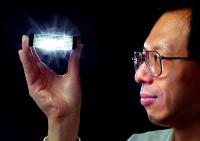Shawn-Yu Lin, Professor of Physics at the Rensselaer Polytechnic Institute, has discovered that 3D optical photonoic crystals can emit a new type of anomalous thermal radiation that could help develop easy, cost-effective solutions for solar energy conversion.
 Shawn-Yu Lin
Shawn-Yu Lin
This new thermal radiation is thought of as the “third light”, and lies between laser light and blackbody radiation. It has certain favourable properties of both laser light and blackbody radiation.
Thermal radiation plays an important role in all aspects of everyday life. The light emitted by incandescent light bulbs and the sun are common types of thermal radiation. This thermal radiation is a random, broad spectrum radiation that can be easily produced. However, it cannot be harnessed easily. Laser light on the other hand, cannot be created easily, but is directional and coherent.
The new thermal radiation type discovered by Lin can be cost-effectively and easily produced. This radiation type is quasi-coherent and sharp.
“It is tremendously exciting when science reveals something new about the fundamental nature of matter, and it is especially gratifying when such a discovery is made by a Rensselaer School of Science faculty member,” said School of Science Dean Curt Breneman. “I am extremely proud of Professor Shawn Lin for identifying a striking new behavior of photonic crystals that could revolutionize the way we think about blackbody radiation—the common effect that explains why hot materials glow red, yellow, or blue-white depending upon their temperature."
"In this groundbreaking work, Professor Lin has revealed that superheated photonic crystals emit much higher intensity radiation than expected, and they do so at a select group of wavelengths in a directional way,” he added. “This is a set of completely new results with potentially wide-ranging implications.”
The law proposed by Max Planck states that a blackbody’s radiation intensity has an upper limit. However, Professor Lin and other members of his team showed that a 3D metallic photonic crystal had the ability to emit electromagnetic radiation at higher levels than those predicted by Planck’s Law. Additionally, the blackbody’s temperature and the radiation wavelength are the only factors that determine the radiation intensity. Furthermore, this radiation intensity also remains steady.
The photonic crystal emitted radiation in a discrete, sharp spectrum that exceeded the upper limit at a wide range of temperatures, and selectively at three different wavelengths. This property could make it favourable for enhancing solar conversion efficiency.
Right now, “solar efficiency is limited by solar radiation’s very broad spectrum, from ultraviolet to infrared,” Lin explained. “The solar cell only responds to certain wavelengths on the spectrum. The rest of the energy is lost.”
The discoveries made in this study increase the possibility of using 3D photonic crystals and the process for converting broad-spectrum solar light to sharp emissions for solar cells.
The study paper entitled, “Anomalous Thermal Radiation from a Three-Dimensional Optical Photonoic Crystal,” has been published in Nanotechnology. Lin is the co-author of this study.